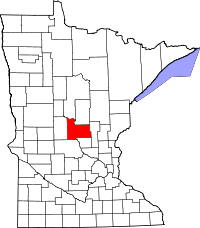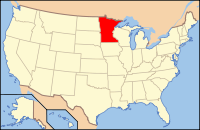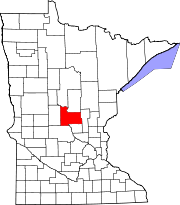- Morrison County, Minnesota
-
Morrison County, Minnesota 
Location in the state of Minnesota
Minnesota's location in the U.S.Founded February 25, 1856 [1] Named for William Morrison and Allan Morrison, two brothers who settled and worked in this area. Seat Little Falls Largest city Little Falls Area
- Total
- Land
- Water
1,153.32 sq mi (2,987 km²)
1,124.50 sq mi (2,912 km²)
28.82 sq mi (75 km²), 2.50%Population
- (2010)
- Density
33,198
28/sq mi (11/km²)Time zone Central: UTC-6/-5 Website www.co.morrison.mn.us Morrison County is a county located in the U.S. state of Minnesota. As of 2010, the population was 33,198.[2] Its county seat is Little Falls[3].
Contents
Geography
According to the 2000 census, the county has a total area of 1,153.32 square miles (2,987.1 km2), of which 1,124.50 square miles (2,912.4 km2) (or 97.50%) is land and 28.82 square miles (74.6 km2) (or 2.50%) is water.[4]
Major highways
 U.S. Highway 10
U.S. Highway 10 Minnesota State Highway 25
Minnesota State Highway 25 Minnesota State Highway 27
Minnesota State Highway 27 Minnesota State Highway 28
Minnesota State Highway 28 Minnesota State Highway 115
Minnesota State Highway 115 Minnesota State Highway 238
Minnesota State Highway 238 Minnesota State Highway 371
Minnesota State Highway 371 Minnesota State Highway 210
Minnesota State Highway 210
Adjacent counties
- Cass County (north)
- Crow Wing County (northeast)
- Mille Lacs County (east)
- Benton County (southeast)
- Stearns County (south)
- Todd County (west)

Cass County Crow Wing County 
Todd County 
Mille Lacs County  Morrison County, Minnesota
Morrison County, Minnesota 

Stearns County Benton County National protected area
Demographics
Historical populations Census Pop. %± 1860 618 — 1870 1,681 172.0% 1880 5,875 249.5% 1890 13,325 126.8% 1900 22,891 71.8% 1910 24,053 5.1% 1920 25,841 7.4% 1930 25,442 −1.5% 1940 27,473 8.0% 1950 25,832 −6.0% 1960 26,641 3.1% 1970 26,949 1.2% 1980 29,311 8.8% 1990 29,604 1.0% 2000 31,712 7.1% 2010 33,198 4.7% U.S. Decennial Census As of the census[5] of 2000, there were 31,712 people, 11,816 households, and 8,460 families residing in the county. The population density was 28 people per square mile (11/km²). There were 13,870 housing units at an average density of 12 per square mile (5/km²). The racial makeup of the county was 98.48% White, 0.21% Black or African American, 0.32% Native American, 0.25% Asian, 0.03% Pacific Islander, 0.15% from other races, and 0.55% from two or more races. 0.64% of the population were Hispanic or Latino of any race. 45.4% were of German, 18.8% Polish, 7.3% Norwegian and 5.7% Swedish ancestry according to Census 2000. 96.7% spoke English, 1.4% Spanish and 1.2% German as their first language.
There were 11,816 households out of which 34.50% had children under the age of 18 living with them, 59.40% were married couples living together, 7.80% had a female householder with no husband present, and 28.40% were non-families. 24.90% of all households were made up of individuals and 11.80% had someone living alone who was 65 years of age or older. The average household size was 2.64 and the average family size was 3.15.
In the county the population was spread out with 28.00% under the age of 18, 8.00% from 18 to 24, 26.70% from 25 to 44, 21.70% from 45 to 64, and 15.60% who were 65 years of age or older. The median age was 37 years. For every 100 females there were 101.20 males. For every 100 females age 18 and over, there were 99.50 males.
The median income for a household in the county was $37,047, and the median income for a family was $44,175. Males had a median income of $31,037 versus $22,244 for females. The per capita income for the county was $16,566. About 7.50% of families and 11.10% of the population were below the poverty line, including 11.40% of those under age 18 and 18.50% of those age 65 or over.
Cities and towns
Cities Townships Unincorporated - Center Valley
- Cushing
- Darling
- Freedhem
- Gregory
- Lincoln
- Little Rock
- Morrill
- North Prairie
- Platte
- Ramey
- Shamineau Park
- Sullivan
- Vawter
† a small part of these cities extends into another county.
History
First the Dakotah and then the Ojibwe Indians lived in the central Minnesota area around the Mississippi River. French and English fur traders and voyageurs traveled through Minnesota from the 17th century to the 19th century. They used the river to transport their goods and trade with the natives. The county was named for fur trading brothers, William and Allan Morrison.
Three prominent explorers lead expeditions along the river through the area that would be known as Morrison County in the 19th century. Zebulon Montgomery Pike came through in 1805. Governor Lewis B. Cass led an expedition through the area in 1820. Joseph N. Nicollet, explorer and scientist, had created the first accurate map of the area along the river in 1836.
Missionaries were some of the areas first European settlers. Methodist missionaries settled temporarily along the Little Elk River in 1838. The Reverend Frederic and Elisabeth (Taylor) Ayer moved to the Belle Prairie area in 1849. They started a mission and school there for the Ojibwe. Father Francis Xavier Pierz came to the area in 1852 and started many communities in central Minnesota, including Sobieski and Rich Prairie (later renamed Pierz) in Morrison County.
The event that prodded further development of the county was the building of Fort Ripley. In order to construct this military outpost, a dam and sawmill were erected in 1849 by the Little Falls Mill and Land Company. This company was formed by James Green, Allan Morrison, Henry M. Rice, John Irvine, John Blair Smith Todd, and Napoleon Jackson Tecumseh Dana. Fort Ripley was built ostensibly to protect the Winnebago Indians, who had been relocated by Henry Rice from Iowa to central Minnesota west of the Mississippi River, between the Crow Wing and Long Prairie rivers. Rice hoped the Winnebago would act as a buffer between the warring Ojibwe and Dakotah Indians. His plan was unsuccessful and the Winnebago were moved to the Blue Earth River in southern Minnesota in 1855.
Little Falls, the county seat, sprung up when a second dam was built by the Little Falls Company (later called the Little Falls Manufacturing Company). This dam washed out, as the first had done, and Little Falls entered a long period of economic depression and stagnation as far as population growth. Bit by bit, Little Falls grew, until it was officially incorporated as a village in 1879.
Another wave of immigration occurred between 1880 and 1920. A wide variety of ethnic groups [6] chose Morrison County for their new home. This wave of immigration was spurred by the construction of the third dam at Little Falls in 1887. A group of investors from Louisville, Kentucky, led by M. M. Williams, provided the financing for this dam. They wanted to be sure their investment was successful. To this end, they worked to encourage other major industries to locate in the city, touting the water power as a prime feature.
Pine Tree Lumber Company, run by Charles A. Weyerhaeuser and Richard "Drew" Musser[7], was one such business that took advantage of the water power, with their operations in Little Falls beginning in 1890. Hennepin Paper Company also started operations that year in the city.
The Louisville, Kentucky, investors were also responsible for drawing up a charter to transform Little Falls from a village to a city. This occurred in 1889, with Nathan Richardson, one of the original organizers of Morrison County, becoming the first mayor of the new city. [8]
See also
References
- ^ http://www.house.leg.state.mn.us/hinfo/govseries/No33.htm
- ^ "2010 Census Redistricting Data (Public Law 94-171) Summary File". American FactFinder. United States Census Bureau. http://factfinder2.census.gov/faces/tableservices/jsf/pages/productview.xhtml?pid=DEC_10_PL_GCTPL2.ST05&prodType=table. Retrieved 25 April 2011.
- ^ "Find a County". National Association of Counties. http://www.naco.org/Counties/Pages/FindACounty.aspx. Retrieved 2011-06-07.
- ^ "Census 2000 U.S. Gazetteer Files: Counties". United States Census. http://www.census.gov/tiger/tms/gazetteer/county2k.txt. Retrieved 2011-02-13.
- ^ "American FactFinder". United States Census Bureau. http://factfinder.census.gov. Retrieved 2008-01-31.
- ^ http://www.morrisoncountyhistory.org/immap.pdf
- ^ http://www.linden-hill.org/history.php
- ^ http://morrisoncountyhistory.org/history/
External links
- Morrison County government’s website
- Morrison County Record (local newspaper)
- Morrison County Death Index
- Morrison County Historical Society
- General Highway Map of Morrison County (western portion and eastern portion) from the Minnesota Department of Transportation
Municipalities and communities of Morrison County, Minnesota Cities Townships Agram | Belle Prairie | Bellevue | Buckman | Buh | Culdrum | Cushing | Darling | Elmdale | Granite | Green Prairie | Hillman | Lakin | Leigh | Little Falls | Morrill | Motley | Mount Morris | Parker | Pierz | Pike Creek | Platte | Pulaski | Rail Prairie | Richardson | Ripley | Rosing | Scandia Valley | Swan River | Swanville | Two Rivers
Unincorporated
communityIndian
reservationFootnotes ‡This populated place also has portions in an adjacent county or counties
Categories:- Minnesota counties
- Morrison County, Minnesota
- Minnesota counties on the Mississippi River
Wikimedia Foundation. 2010.

